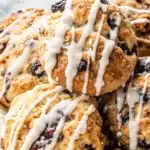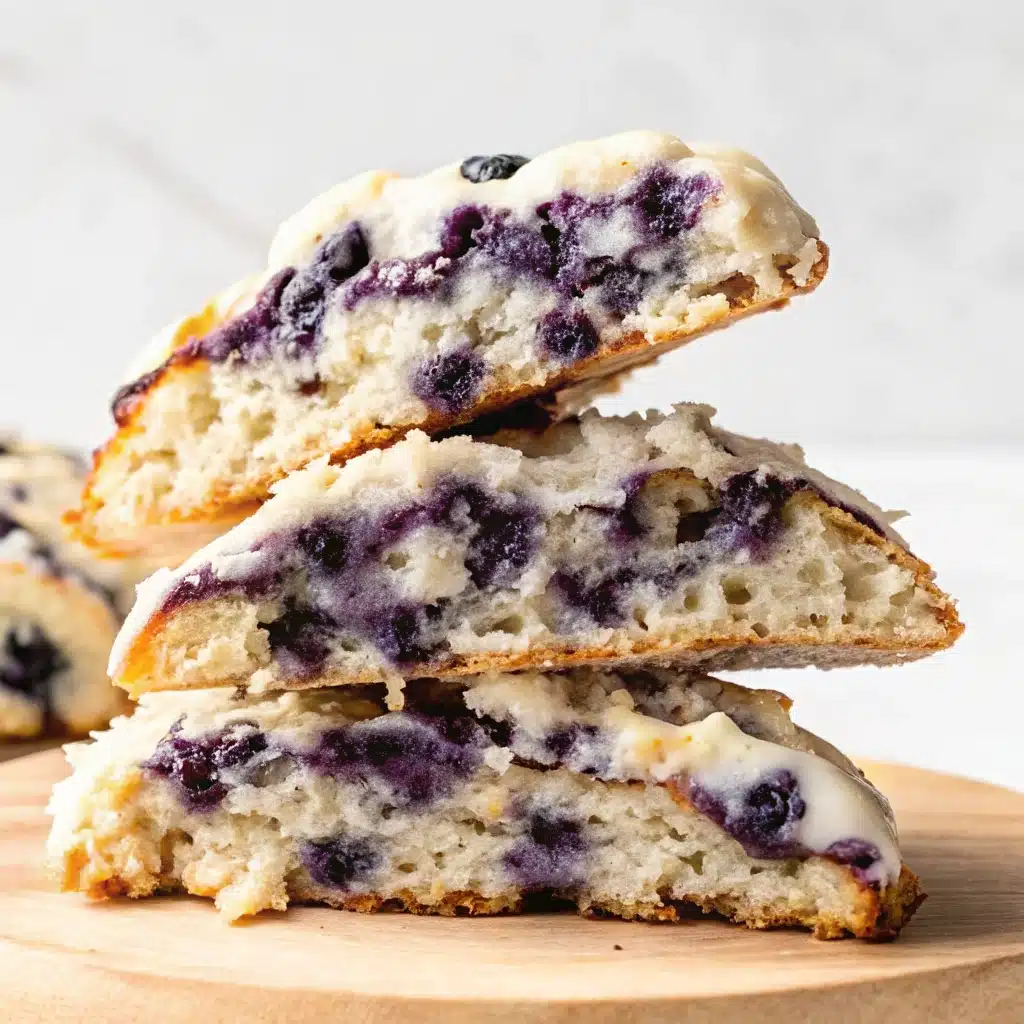Blueberry Biscuits have always felt like the dessert that knew how to comfort me—flaky, soft, and bursting with pockets of tangy-sweet blueberries. I’m Mary, known fondly around Bath as The Pudding Lady. My love for baking was born in the warm chaos of my mum’s pantry, where flour clouds danced in the air and golden syrup glued every lid shut. That’s where the spark lit.

In this article, I’ll guide you through everything you need to know about Blueberry Biscuits—from what makes the best ones rise just right, to mistakes that cause them to crumble apart. We’ll cover tips, recipes, variations, storage hacks, and even some old-fashioned pudding magic along the way.
Table of Contents
Blueberry Biscuits
What Are Blueberry Biscuits?
At their core, blueberry biscuits combine the rich, flaky texture of classic buttermilk biscuits with the vibrant burst of fresh or frozen blueberries. Unlike muffins or scones, biscuits have a soft, airy interior and a slightly crisp, golden crust. The addition of blueberries transforms them from a savory staple into a delightful sweet treat, perfect with coffee or tea.
They often feature a lightly sweetened dough and can be topped with a sugar glaze, lemon drizzle, or even butter and honey. The result? A perfect balance between savory and sweet.
Print
Blueberry Biscuits
- Total Time: 33 minutes
- Yield: 8 biscuits 1x
- Diet: Vegetarian
Description
Fluffy, buttery biscuits bursting with fresh blueberries—perfect for breakfast or a sweet afternoon snack.
Ingredients
- 2 cups all-purpose flour
- 1 tablespoon baking powder
- 1/2 teaspoon baking soda
- 1/2 teaspoon salt
- 2 tablespoons sugar
- 1/2 cup cold unsalted butter, cubed
- 3/4 cup buttermilk
- 1 cup fresh or frozen blueberries
- 1 tablespoon coarse sugar (optional, for topping)
Instructions
- Preheat oven to 425°F (220°C) and line a baking sheet with parchment paper.
- In a large bowl, whisk together flour, baking powder, baking soda, salt, and sugar.
- Cut in the cold butter using a pastry cutter or fork until the mixture resembles coarse crumbs.
- Stir in buttermilk just until combined. Gently fold in blueberries.
- Turn dough onto a floured surface and pat into a 1-inch thick round.
- Cut into rounds using a biscuit cutter and place on the prepared baking sheet.
- Sprinkle tops with coarse sugar if using.
- Bake for 15–18 minutes or until golden brown. Serve warm.
Notes
Handle dough gently to keep biscuits tender. Frozen blueberries work well but do not thaw before using.
- Prep Time: 15 minutes
- Cook Time: 18 minutes
- Category: Breakfast
- Method: Baking
- Cuisine: American
Nutrition
- Serving Size: 1 biscuit
- Calories: 210
- Sugar: 7g
- Sodium: 270mg
- Fat: 10g
- Saturated Fat: 6g
- Unsaturated Fat: 3g
- Trans Fat: 0g
- Carbohydrates: 27g
- Fiber: 1g
- Protein: 3g
- Cholesterol: 25mg
Why Are Blueberry Biscuits Gaining Popularity?
Blueberry biscuits are trending for good reason:
- Quick to make – Most recipes are ready in under 30 minutes.
- Versatile – Enjoy them warm for breakfast or pack them for a sweet snack.
- Elevated comfort food – With minimal ingredients, you get maximum flavor.
- Seasonal appeal – Blueberries are abundant during summer, making these biscuits a fresh, fruity choice.
Social media has also helped boost their popularity. Videos of dough being folded, blueberries bursting, and biscuits baking to golden perfection create serious food envy—and inspire home bakers to give them a try.
From grandma’s kitchen to gourmet brunch spots, these biscuits have carved out a spot as an American favorite.
Ingredients

hoosing the Right Blueberries: Fresh vs. Frozen
When it comes to blueberry biscuits, the choice between fresh or frozen blueberries can impact flavor, texture, and even baking time.
Fresh blueberries offer a burst of tart-sweet flavor and hold their shape better during baking. They don’t bleed into the dough as much, keeping the biscuit appearance clean and vibrant.
Frozen blueberries, on the other hand, are convenient and available year-round. However, they tend to release more juice as they bake, which can slightly discolor the dough and add extra moisture. If using frozen, don’t thaw them before mixing into the dough—keep them frozen until right before baking.
Pro Tip: Toss blueberries in a tablespoon of flour before folding them into the dough. This prevents them from sinking to the bottom and evenly distributes them throughout the biscuits.
Discover great ideas like our Blueberry Crumble Recipe for another way to enjoy juicy berries in baked form.
Essential Base Ingredients for Soft Biscuits
Blueberry biscuits may sound simple, but every ingredient plays a crucial role in achieving the perfect texture and taste.
Here’s a breakdown of what you’ll need:
| Ingredient | Purpose in Recipe |
|---|---|
| All-Purpose Flour | Provides structure and body. Look for unbleached if possible. |
| Baking Powder | The leavening agent for rise and fluff. Use fresh powder. |
| Granulated Sugar | Adds light sweetness to balance the berries. |
| Cold Unsalted Butter | Key to flaky, tender layers. Must be very cold. |
| Buttermilk or Milk | Adds moisture and activates the baking powder. |
| Salt | Enhances flavor; don’t skip it. |
| Blueberries | The star ingredient—fresh or frozen both work well. |
The secret to soft, bakery-style blueberry biscuits lies in the butter. You want the butter cold and in chunks so it melts during baking, creating steam and flakiness.
Don’t miss our Blueberry Crumble Cheesecake for another clever twist on this berry.
The Science Behind Perfect Biscuit Texture
Understanding Gluten and Fat Ratios in Biscuits
Texture makes or breaks a biscuit. To get that tender, airy structure, you need to master the balance between gluten formation and fat distribution.
Gluten is a protein that forms when flour mixes with liquid. The more you mix, the more gluten develops—great for chewy bread, but not for fluffy blueberry biscuits. Too much gluten results in tough, dense biscuits. That’s why gentle mixing is key—it preserves tenderness and prevents a dense texture.
On the other side of the equation is fat, specifically cold butter. Fat shortens gluten strands, leading to a tender texture and creating airy pockets within the dough. As butter melts in the oven, steam is released, causing layers to puff up. This is what creates the signature rise and flaky layers that make biscuits so irresistible.
So, keep the mixing light and the butter cold. Use a pastry cutter or your hands, and stop as soon as the dough holds together. It should look a little shaggy—that’s ideal.
Looking for inspiration? Try our fruit-forward Lemon Blueberry Mini Bundt Cakes for another layered texture experience.
Why Cold Ingredients Matter in Biscuit Dough
Cold butter, cold buttermilk, even cold flour if possible—it all helps. Why?
Because warm ingredients cause the butter to melt before the biscuit hits the oven. And if that happens, your biscuits will flatten, spreading out instead of rising.
Here’s a quick chart explaining why temperature matters:
| Ingredient | Effect of Cold Temperature |
|---|---|
| Cold Butter | Melts in the oven to create steam = flaky layers |
| Cold Buttermilk | Slows gluten formation = tender texture |
| Cold Flour | Helps maintain dough temperature during mixing |
Keep everything cold until your biscuits are in the oven. You can even chill the dough for 10 minutes before baking for extra rise.
Fun Fact: Some bakers freeze their butter and grate it directly into the flour—this ensures even distribution and optimal flakiness.
Step-by-Step Recipe for Classic Blueberry Biscuits
Ingredients List and Prep Time

Ready to bake the fluffiest, fruit-packed blueberry biscuits from scratch? Here’s what you need to whip up a dozen warm, golden treats in less than 30 minutes.
Ingredients:
- 2 cups all-purpose flour (plus extra for dusting)
- 1 tbsp baking powder
- ½ tsp salt
- 3 tbsp granulated sugar
- ½ cup (1 stick) cold unsalted butter, cubed
- ¾ cup buttermilk (or whole milk)
- 1 tsp vanilla extract (optional)
- 1 cup fresh or frozen blueberries (do not thaw)
- 1 tbsp flour (to coat blueberries)
- Optional: coarse sugar for topping or glaze
Prep Time Breakdown:
| Step | Time |
|---|---|
| Prep Ingredients | 10 mins |
| Mixing Dough | 5 mins |
| Baking Time | 15 mins |
| Total Time | 30 mins |
Don’t miss our Blueberry Cornbread for another quick bake bursting with blueberry flavor.
Mixing, Kneading, and Baking Process Explained
Step 1: Preheat and Prep
Preheat the oven to 425°F (220°C) and line a baking sheet with parchment paper for easy cleanup and even baking. Consistent heat is key to perfect blueberry biscuits that rise evenly.
Step 2: Combine Dry Ingredients
In a large mixing bowl, whisk together the flour, baking powder, salt, and sugar until evenly combined. This ensures your blueberry biscuits bake with consistent flavor and rise.
Step 3: Cut in the Butter
Add cold butter cubes to the dry mixture. Use a pastry cutter or your fingers to work it in until the dough resembles coarse crumbs. Cold butter is what gives blueberry biscuits their flakey, melt-in-your-mouth texture.
Step 4: Add the Blueberries
Toss blueberries with 1 tbsp flour to prevent them from sinking or bleeding into the dough. Gently fold them into your biscuit mix for evenly distributed, juicy bursts in every bite.
Step 5: Add Liquid
Pour in the buttermilk and optional vanilla extract. Mix only until the dough comes together—overworking it can lead to tough, dense biscuits. Overmixing toughens biscuits, even fruity ones like blueberry biscuits.
Step 6: Shape and Cut
Turn the dough onto a floured surface. Pat into a rectangle about ¾-inch thick. Fold and press it down gently two to three times to create layers. Use a biscuit cutter or the rim of a glass to cut out your blueberry biscuits for uniform shapes and even bakin.
Arrange the biscuit rounds on the baking sheet: close together for soft sides or spaced apart for crispier edges.
Step 7: Bake
Bake for 13–15 minutes or until golden brown on top. Your kitchen will smell like a bakery—fruity, warm, and irresistible.
Optional: Finish your blueberry biscuits with melted butter or a light lemon glaze for extra shine and sweetness.
Tip: Sprinkle coarse sugar on top before baking to add crunch and visual appeal.
Common Mistakes When Baking Blueberry Biscuits
Why Do Biscuits Crumble or Fall Apart?
One of the biggest frustrations when baking blueberry biscuits is when they fall apart or turn out too dry. This typically boils down to a few key mistakes:
- Too much flour – Scooping directly from the bag can compact flour and cause you to add more than needed. Always spoon flour into your measuring cup, then level it off with a knife to ensure accurate measurement and prevent dense dough.
- Overbaking – Even an extra 2 minutes in the oven can dry out your biscuits. Blueberry-filled doughs bake a little faster due to moisture from the fruit.
- Not enough fat or liquid – Fat keeps the structure tender and moist. Using too little butter or liquid will result in dry, crumbly biscuits lacking the desired tenderness.
Another overlooked cause? Crushing the blueberries during mixing. This releases juice, adds unwanted moisture, and weakens the dough structure.
If you’ve had trouble in the past, try chilling the dough briefly before baking. This firms up the butter and berries, reducing spreading and helping your blueberry biscuits stay tall and flakey.
How Overworking Dough Can Ruin Texture
If there’s one golden rule to biscuit baking, it’s this: handle the dough as little as possible.
Overworking the dough encourages gluten development, which leads to:
- Tough, chewy texture
- Flat biscuits
- Reduced flakiness
This is especially true for blueberry biscuits, where the berries add extra moisture. After adding the liquid, stir gently just until everything comes together—the dough should look rough and shaggy, which is exactly what you want.
Pro Tip: Use your hands instead of a rolling pin. Pat the dough out gently—just enough to cut your biscuits.
You can also learn from soft-texture recipes like our Peach Muffins where fruit and batter balance is key.
Even experienced bakers can get too confident and overdo it. If your past biscuits turned out dense or flat, chances are you kneaded the dough too much or pressed it too thin.
Health & Nutrition Facts of Blueberry Biscuits
How Many Calories in a Blueberry Biscuit?
Whether you’re watching your calorie intake or just curious, it’s smart to know what’s in your baked goods.
On average, a standard homemade blueberry biscuit contains:
| Serving Size | Calories | Fat (g) | Carbs (g) | Sugar (g) | Protein (g) |
|---|---|---|---|---|---|
| 1 Biscuit (85–100g) | 210–250 | 9–12 | 30–36 | 8–12 | 3–5 |
Calories may vary depending on:
- The amount of butter used
- Added sugar or glaze
- Type of milk or buttermilk
- Glaze or topping additions
Using whole milk and sugar glaze? Expect more calories. Swap in low-fat milk or skip the glaze for a lighter option.
You can still indulge without guilt—especially if you control portion size or use some clever substitutions.
Low-Calorie Alternatives for Health-Conscious Bakers
Want to enjoy blueberry biscuits without the calorie overload? Here are smart swaps to lighten them up without compromising taste:
| Traditional Ingredient | Healthier Alternative |
|---|---|
| All-purpose flour | Half whole wheat or almond flour blend |
| Unsalted butter | Use Greek yogurt or unsweetened applesauce |
| Buttermilk | Low-fat or plant-based milk + lemon juice |
| Sugar | Try coconut sugar or a monk fruit blend |
| Glaze | Dust with powdered erythritol |
You can also reduce the biscuit size slightly to lower the total calories per serving.
Bonus: Blueberries themselves are packed with antioxidants, fiber, and vitamin C—so you’re already making a heart-healthy choice!
Variations and Creative Twists on Blueberry Biscuits
Lemon-Glazed Blueberry Biscuits
If you’re looking to add a citrusy zing to your classic blueberry biscuits, a lemon glaze is the perfect upgrade. This variation balances the sweetness of the berries with a tart finish that makes every bite pop.
Here’s how to make the glaze:
Simple Lemon Glaze Recipe:
- ½ cup powdered sugar
- 1 tbsp fresh lemon juice
- ½ tsp lemon zest (optional)
Instructions:
Whisk all ingredients together until smooth. Drizzle over the slightly cooled biscuits, then let the glaze set for a few minutes before serving.
This twist is especially popular for brunch spreads or as a light summer dessert.
Tip: Want extra lemon flavor? Add ½ tsp lemon zest directly into the dough when mixing.
Vegan and Gluten-Free Options
Good news! You don’t have to give up blueberry biscuits if you’re dairy-free, egg-free, or gluten-sensitive. With a few simple swaps, you can enjoy delicious results.
For Vegan Blueberry Biscuits:
- Replace butter with vegan butter or chilled coconut oil
- Use almond milk + 1 tsp lemon juice instead of buttermilk
- Swap sugar with organic cane sugar or maple syrup
For Gluten-Free Blueberry Biscuits:
- Use a gluten-free 1:1 flour blend
- Add ½ tsp xanthan gum if the flour mix doesn’t contain it
- Be gentle when mixing—GF dough can be more fragile
These versions still bake up fluffy and flavorful, especially if you keep your ingredients cold and handle the dough minimally.
Looking for inspiration? Try our Gluten-Free Blueberry Crumble—it’s proof that going gluten-free can still mean delicious.
Storage, Reheating & Serving Suggestions
Best Ways to Store Biscuits to Keep Them Fresh
Freshly baked blueberry biscuits are best enjoyed warm, but that doesn’t mean you can’t make them ahead or save leftovers. Proper storage helps keep them moist, tender, and full of flavorl.
Short-Term Storage (1–2 Days):
- Allow the biscuits to cool fully on a wire rack before storing to prevent condensation and sogginess.
- Store in an airtight container lined with a paper towel to help absorb excess moisture and maintain texture.
- Keep at room temperature—not in the fridge, which can dry them out.
Long-Term Storage (Up to 3 Months):
- Individually wrap each biscuit in plastic wrap or foil to preserve freshness and prevent drying out.
- Place the wrapped biscuits in a freezer-safe bag, removing as much air as possible to prevent freezer burn.
- Label with the date.
To thaw, place the wrapped biscuit on the counter for 30–45 minutes or reheat directly from frozen.
Tip: If freezing glazed blueberry biscuits, glaze them after reheating to maintain the best texture.
How to Reheat Without Losing Fluffiness
The goal is to reheat your blueberry biscuits without turning them rubbery or soggy. Here’s how:
| Method | Steps |
|---|---|
| Oven | Preheat to 325°F. Wrap biscuit in foil. Heat for 10–12 mins. |
| Microwave | Wrap in a damp paper towel. Microwave 20–30 seconds at 70% power. |
| Air Fryer | Set to 320°F. Heat for 3–4 minutes. Watch closely to avoid overbrowning. |
If you’re reheating frozen biscuits, add a couple extra minutes to each method.
Serving Tip: Warm blueberry biscuits pair beautifully with lemon curd, vanilla butter, or whipped cream cheese.
Expert Tips and Pro Techniques
What Is the Secret to the Best Biscuit?
Ask any Southern baker, and you’ll hear the same answer: cold ingredients + gentle hands = biscuit magic. But let’s break that down further for your blueberry biscuits to truly shine.
1. Freeze the Butter:
Use frozen butter and grate it directly into the flour for even distribution and flakier layers. This helps distribute the fat evenly and creates tiny steam pockets during baking—key for that flaky rise.
2. Don’t Overmix:
Once the liquid hits the dry ingredients, the gluten starts forming. Stir until the dough just comes together and stop. Overmixing is the #1 cause of dense biscuits.
3. Fold for Layers:
Gently fold the dough over itself 2–3 times before cutting. This mimics puff pastry layering and makes your blueberry biscuits tall and tender.
4. Bake Close Together (or Not):
Want soft sides? Arrange the biscuits so they’re touching on the pan—this helps them rise higher and stay soft on the sides. Want crispy edges? Space them an inch apart. It’s all about the finish you prefer.
5. Chill the Dough:
After shaping, pop your biscuits in the fridge for 10–15 minutes before baking. This prevents butter from melting too soon and gives you better lift.
Don’t miss our Scones Recipe for another great example of flake-building techniques in baked goods.
Should You Use Milk or Water for Softer Biscuits?
This one’s easy: Milk or buttermilk wins every time.
Using milk (especially whole milk or buttermilk) brings:
- Creaminess and a richer flavor
- More moisture and tenderness
- Natural acidity that reacts with baking powder for a fluffier texture
Water lacks fat and protein, so it can result in bland or dry biscuits. If you’re out of dairy, opt for plant-based milk with some fat content—like oat or almond milk mixed with a teaspoon of lemon juice to replicate buttermilk.
Quick comparison:
| Liquid | Result in Biscuit |
|---|---|
| Whole Milk | Soft, creamy texture, subtle richness |
| Buttermilk | Slight tang, very tender and fluffy |
| Water | Dry, bland, flatter biscuits |
| Almond Milk | Works well if paired with fat (like oil) |
So yes—blueberry biscuits are better with milk, every time.
Conclusion
There’s no denying the comforting charm of freshly baked blueberry biscuits—flaky, buttery layers studded with sweet bursts of blueberry goodness. Whether you’re a beginner baker or a seasoned kitchen pro, mastering these biscuits starts with cold ingredients, gentle handling, and just the right balance of flavors.
You’ve now got everything: the science, the secrets, the recipe, and even healthy or vegan alternatives. With these tips, your blueberry biscuits will rise to the occasion—every single time.
Don’t miss our Blueberry Crumble Cheesecake for a rich dessert twist on your favorite berry, or explore more with our Mini Blueberry Bundt Cakes.
Fore more recipes follow me in Facebook, medium and Pinterest
FAQs
What is the secret to the best biscuit?
The secret lies in keeping your ingredients cold, especially the butter, and mixing the dough as little as possible. For blueberry biscuits, this technique ensures tender, flaky layers that hold juicy blueberries without falling apart. Folding the dough a few times before cutting also adds height and texture.
How many calories does a blueberry biscuit have?
A typical homemade blueberry biscuit contains 210–250 calories, depending on the recipe and whether it includes toppings like a glaze or butter. Using lower-fat dairy or smaller biscuit portions can reduce calorie count without sacrificing flavor.
What makes your biscuits fall apart?
Biscuits often fall apart when the dough is too dry or overmixed. In the case of blueberry biscuits, crushed berries can release excess juice, weakening the structure. Be sure to measure flour properly, keep butter cold, and mix just until the dough comes together.
Are biscuits better with milk or water?
Milk—or better yet, buttermilk—is ideal for soft, fluffy blueberry biscuits. Water lacks the fat and protein needed for a tender crumb. If you need a dairy-free option, plant-based milk with added lemon juice can work as a substitute.




